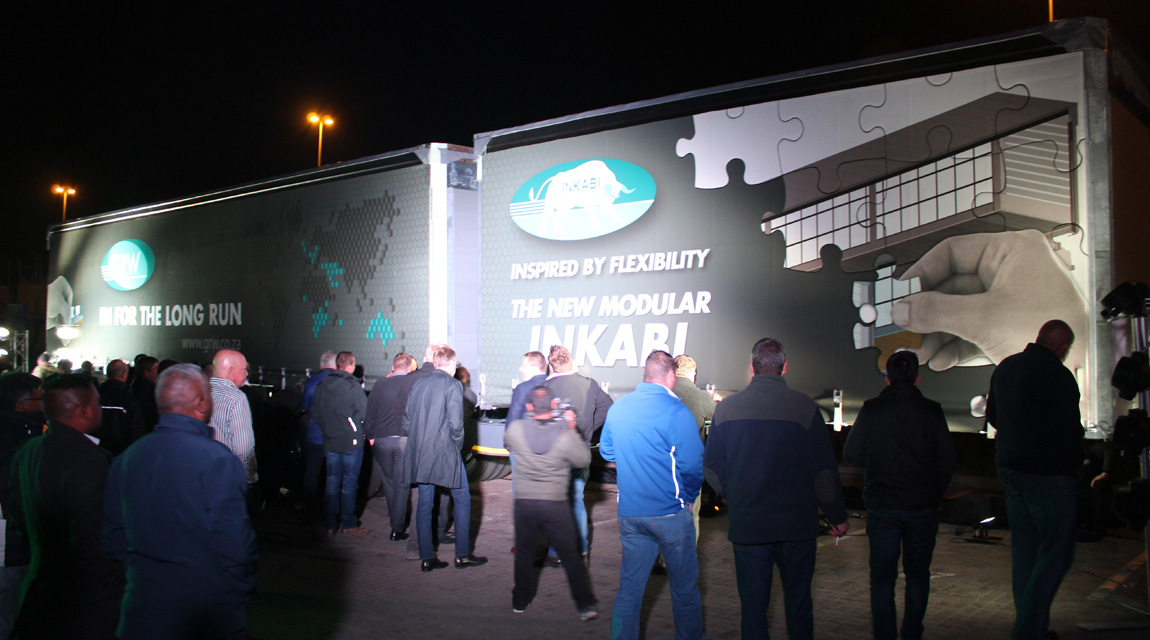Return of the bull

GRW Trailers launched the next generation of its tautliner trailer series, the Inkabi 2.0, at a packed-out function at its Boksburg premises last night.
Inkabi is Zulu for bull, and symbolises the strength of the curtainsider, says GRW CEO, Gerhard van der Merwe.
The Inkabi 2.0 builds on experience gained with the original version, launched in March 2015, and features many advanced design elements from GRW’s new partner, German trailer manufacturer Schmitz Cargobull (SCB).
Key among these is the use of the SCB bolted technology. Instead of welding, the assembly of the entire chassis and all other functional components is bolted. What makes the SCB bolt unique is that its splined section shears through both bolting surfaces, which means there is no need to secure the bolt head during fastening. The hole diameters have a very small tolerance ensuring accuracy and a tight fit, and the bolted assemblies offer superior fatigue life over welded assemblies.
According to Van der Merwe, this bolting technology will be applied across the GRW product range as it allows for dissimilar materials to be joined. This speaks to a key component of the Inkabi 2.0’s design, its modularity.
“Modularity allows for scale-ability – these bolted structures can be economically assembled in other locations. Modularity with bolted technology also ensures accuracy. All of the components are manufactured in high-precision jigs and welded robotically,” Van der Merwe states.

There are many other enhancements, which make the Inkabi 2.0 bigger and better. Among these are the load strap winch, which is a bolted, galvanised assembly that is easily replaceable when damaged. The wall sections of the bulkheads are made from anodised aluminium sandwich extrusions, offering superior strength and corrosion resistance, says Van der Merwe.
The GRW roof structure remains the same, except for an adjustable mounting interface with the bulkheads offering height-adjustable roofs for fixed roofs. An optional lifting roof is available.
The Birch plywood floor, a controversial design feature of the first Inkabi generation, has proved its durability and received positive responses from clients, says Van der Merwe. It therefore remains, except now as 27-mm boards instead of 18.
“The board orientation has changed from longitudinal between the chassis rails to perpendicular over the chassis rails. This allowed for the removal of a top hat section that covered the main beams and the result of this is that the deck is uninterrupted and 100-percent flat,” Van der Merwe explains.
Various models of the Inkabi 2.0 will be available: 6/12, 6/12 high volume and 7/11 configurations. Customers have a range of spec options from which to choose, these include: An overhead load-securing system for easy securing of high loads; Hazchem specification; rear doors and interleading doors for through loading; and a GRW-designed adjustable racking system.
The braking system on all models is Wabco EBS with BPW drum and disc brakes, SAF intra-drum and discs brakes or GRW Propar drum brakes.
“The best word to describe the Inkabi 2 compared to Inkabi 1 is ‘more’,” says Van der Merwe. “More payload, more options, more money in your pocket, more piece of mind, more aftersales and service offerings,” he concludes.
Published by
Focus on Transport
focusmagsa



